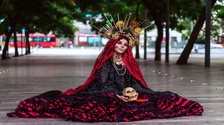Search from various 영어 teachers...
Ana Maria
In what context use 잘가 and 잘가요?
2018년 8월 9일 오전 3:37
답변 · 5
2
There are seven verb paradigms or speech levels in Korean, and each level has its own unique set of verb endings which are used to indicate the level of formality of a situation.
Refer to https://en.wikipedia.org/wiki/Korean_speech_levels
Here are four common speech levels
1. 잘가십시오 is Hasipsio-che(하십시오체)
This conversational style is generally called either the "formal" or the "formal polite." This is a common style of speaking. A conversation with a stranger will generally start out in this style and gradually fade into more and more frequent haeyo-che. It is used
between strangers at the start of a conversation
among male co-workers
to customers
2. 잘가요 is Haeyo-che(해요체)
This speech style is called the "polite" style in English. It is remarkable in that it is used both with higher level pronouns. It is used mainly:
In Korean phrasebooks for foreigners.
Between strangers, especially those older or of equal age.
Between female co-workers or friends.
By younger speakers as a less old-fashioned alternative to the hao-che.
3. 잘가라 Haera-che(해라체)
This conversational style is generally called the "plain" style. In writing and quoting, the plain style is the equivalent of the third person. It is used:
To close friends or relatives of similar age, and by adults to children.
In impersonal writing and indirect quotations ("She said that...").
In grammar books, to give examples.
In some exclamations.
4. 잘가 is Hae-che(해체)
This conversational style is called the "intimate" in English. It is used
Between close friends and relatives.
When talking to children.
2018년 8월 9일
As what i understand, 잘가요 used formally
2018년 8월 9일
아직도 답을 찾지 못하셨나요?
질문을 남겨보세요. 원어민이 도움을 줄 수 있을 거예요!
Ana Maria
언어 구사 능력
영어, 한국어, 스페인어
학습 언어
영어
좋아할 수도 있는 읽을거리

🎃 October Traditions: Halloween, Holidays, and Learning Portuguese
21 좋아요 · 7 댓글

The Curious World of Silent Letters in English
19 좋아요 · 11 댓글

5 Polite Ways to Say “No” at Work
25 좋아요 · 7 댓글
다른 읽을거리
